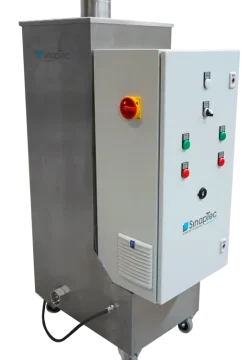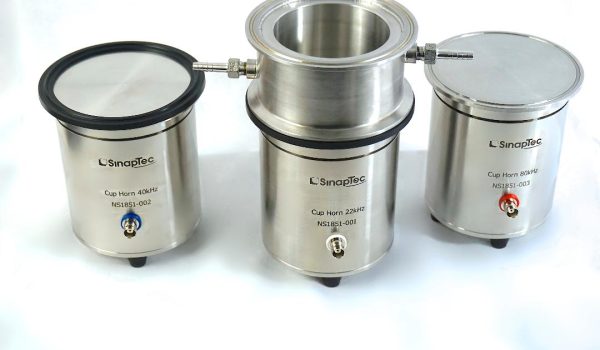Ultrasound-Assisted Extraction: Efficient and Eco-Friendly Solutions
Have a question about any of the products below? Need a quote or more information? Contact us via the menu above or the link at the bottom of this page.
Introduction
Ultrasound-assisted extraction uses the mechanical energy of ultrasonic waves to extract valuable molecules from plant material.
Power ultrasound is one of the modern technologies used for extracting essential oils, flavonoids, alkaloids, tannins, and proteins, both at laboratory and industrial scale.
Pharmacology, cosmetics, food, and aromatherapy are sectors where the quality and functionality of extracted molecules are essential. Ultrasound has proven to be an effective technology that preserves the properties of these molecules, especially thermolabile ones.
Ultrasonic Plant Extraction Test
How Does Ultrasound Extraction Work?
When ultrasound with sufficiently high amplitude is generated in a liquid, microscopic cavitation bubbles form and implode. The implosion of these bubbles creates intense mechanical and thermal effects (up to 1000 bar and 5000 kelvin) at the local level within the liquid.
This process releases valuable molecules by breaking down plant cell membranes and walls, increasing their surface contact with the extraction solvent. This enhances extraction yields and reduces the contact time required.
OEM Ultrasound Modules for Extraction
Ultrasonic Pipe for Efficient Scale-Up
The ultrasonic pipe is a vibrating tube that offers exceptional treatment uniformity, whether the process requires continuous flow or recirculation. Made of stainless steel, custom-built, and modular in integration, it is the most flexible technical solution we offer—without compromising ultrasonic efficiency.


The Ultrasonic Rod for Easy Integration
The ultrasonic rod can be adapted to an existing tank or pipeline and is made of solid titanium for harsh environments. Our 24/7 testing over one year has shown no decline in performance!
Its fins generate strong acoustic streaming to maximize ultrasonic effects, even in large volumes.
Advantages of Ultrasound-Assisted Extraction
Compared to conventional methods, ultrasound extraction is often faster and can be performed at moderate temperatures, preserving the integrity of extracted molecules. It can also reduce the amount of solvent used and allow for the use of less harmful solvents, provided the target molecules are miscible with them.
Like any process, ultrasound extraction requires parameter optimization to ensure optimal results:
- Ultrasonic power
- Sonication time
- Ultrasonic cycle
- Extraction solvent
- Preparation of raw material
Which Frequency Should You Use for Ultrasound Extraction?
Most commercially available ultrasound equipment for extraction operates around 20 kHz, as this is where the mechanical effects are most significant. Efficiency tends to decrease as frequency increases. It is also generally easier to design equipment capable of delivering substantial power at these lower frequencies.
However, depending on the desired outcome and the specific industry, operating at higher frequencies can be useful—or even optimal.
In the agri-food sector, for instance, microalgae are a readily available and cultivable biological resource that contain numerous valuable molecules such as proteins, polysaccharides, and pigments.
As an example, microalgae can contain up to twice as much protein as meat or legumes, and as much as certain insect species. This makes them a promising resource for human and/or animal nutrition.
Many studies have demonstrated the potential of ultrasound at low frequencies (20 to 40 kHz) for extracting proteins from microalgae. However, working at higher frequencies (e.g., 100 kHz) may enable the extraction of other metabolites beyond proteins, such as exopolysaccharides (Delran et al., 2023(1)). These molecules are of industrial interest in the food industry (as stabilizers), in pharmaceuticals (as anti-inflammatories), and in agriculture (to improve soil water retention).
In the energy sector, the heavy reliance on fossil fuels and the environmental impact of their consumption have driven research and development into renewable energy sources, such as non-food biomass (wheat straw, flax shives, corn stalks, etc.).
Biomass can be converted into biogas and fuels using hemicellulose and cellulose, and into heat by combusting lignin. Lignin also has high-value applications as a substitute for petroleum-derived products in material manufacturing.
To fully exploit biomass for these various uses and optimize its potential, it is essential to purify and separate its components. For example, biogas production requires microorganisms and enzymes to digest biomass sugars, but lignin obstructs their access. In the case of flax shive pretreatment, combining ultrasound with conventional delignification methods enables faster and more efficient lignin removal, thereby improving biogas yield. Depending on the method used, delignification increases ranging from 8.5% to 135.5% have been observed (Kalawoun, 2023(2)).
Notably, in this case, the best results were obtained at 100 kHz rather than 22 kHz, demonstrating that frequency selection is also a key parameter in optimizing ultrasound for a given process.
To study the effect of frequency on a small scale before scaling up, SinapTec offers Cup-Horn technology.
Cup-Horn: Optimize Your Ultrasound Extraction Process at Lab Scale
The Cup-Horn is a lab tool used to study frequency effects between 22 kHz and 100 kHz on your extraction process. It helps you understand all ultrasound parameters influencing extraction, assess the technology’s suitability, and quantify the results. This greatly facilitates scale-up.
We then develop a technical specification together, based on your production constraints (footprint, maintenance, batch or continuous extraction) and the results obtained.

Case Study – Scale-Up of Plant Oil Extraction
Objective: Scale up from 500 mL batch extraction to 50 L.
Context: A company demonstrated the effectiveness of ultrasound in extracting essential oils from plant material in lab trials. Wanting to maintain the same results at a larger scale (from 500 mL to 50 L), they contacted us.
Parameter Assessment: The extractions were done using a non-SinapTec lab device with a 6 mm probe at 20 kHz and claimed 650 W power over 10 minutes (50% ON / 50% OFF).
Based on our experience, we suspected this power figure was inaccurate given the probe size and volume. We recommended a calorimetric study, which revealed the actual power was 35 W.
SinapTec Proposal: We proposed renting one of our systems capable of replicating the client’s lab-scale results. We selected suitable equipment based on energy density ratios between the two scales, aiming for a 30-minute extraction time.
Results: After successful testing, the client confirmed that the results matched their initial lab trials both qualitatively and quantitatively. Spectrophotometric analysis confirmed that active compounds were present in sufficient amounts and remained intact. A rod-type device was then custom-built to integrate into the final tank.
Follow-Up: The client has been using our system since June 2021 for customized extract production and is fully satisfied. Only one alert occurred in February 2024 from our NexTgen generator due to a configuration issue, which was resolved the same day using our PC software and diagnostic tools.
In Summary
In many respects, ultrasound-assisted extraction is considered a more environmentally friendly and highly versatile technique for processing plant-based raw materials. It is suitable for a wide range of industries looking to intensify their processes—on existing or newly designed systems—while preserving extract quality.
All that’s left is to contact us and discover the many advantages of this technology, which we have been developing and manufacturing since 1984.
- https://doi.org/10.1016/j.ultsonch.2023.106492
- Application of acoustic cavitation to the pretreatment of lignocellulosic biomass from flax and to the development of catalysts for catalytic reforming
